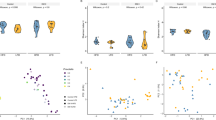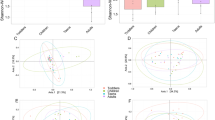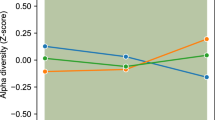Abstract
The involvement of the gut microbiota in metabolic disorders, and the ability of whole grains to affect both host metabolism and gut microbial ecology, suggest that some benefits of whole grains are mediated through their effects on the gut microbiome. Nutritional studies that assess the effect of whole grains on both the gut microbiome and human physiology are needed. We conducted a randomized cross-over trial with four-week treatments in which 28 healthy humans consumed a daily dose of 60 g of whole-grain barley (WGB), brown rice (BR), or an equal mixture of the two (BR+WGB), and characterized their impact on fecal microbial ecology and blood markers of inflammation, glucose and lipid metabolism. All treatments increased microbial diversity, the Firmicutes/Bacteroidetes ratio, and the abundance of the genus Blautia in fecal samples. The inclusion of WGB enriched the genera Roseburia, Bifidobacterium and Dialister, and the species Eubacterium rectale, Roseburia faecis and Roseburia intestinalis. Whole grains, and especially the BR+WGB treatment, reduced plasma interleukin-6 (IL-6) and peak postprandial glucose. Shifts in the abundance of Eubacterium rectale were associated with changes in the glucose and insulin postprandial response. Interestingly, subjects with greater improvements in IL-6 levels harbored significantly higher proportions of Dialister and lower abundance of Coriobacteriaceae. In conclusion, this study revealed that a short-term intake of whole grains induced compositional alterations of the gut microbiota that coincided with improvements in host physiological measures related to metabolic dysfunctions in humans.
Similar content being viewed by others
Log in or create a free account to read this content
Gain free access to this article, as well as selected content from this journal and more on nature.com
or
References
Adom KK, Liu RH . (2002). Antioxidant activity of grains. J Agric Food Chem 50: 6182–6187.
Alminger M, Eklund-Jonsson C . (2008). Whole-grain cereal products based on a high-fibre barley or oat genotype lower post-prandial glucose and insulin responses in healthy humans. Eur J Nutr 47: 294–300.
Amar J, Burcelin R, Ruidavets JB, Cani PD, Fauvel J, Alessi MC et al (2008). Energy intake is associated with endotoxemia in apparently healthy men. Am J Clin Nutr 87: 1219–1223.
Bäckhed F, Ding H, Wang T, Hooper LV, Koh GY, Nagy A et al (2004). The gut microbiota as an environmental factor that regulates fat storage. Proc Natl Acad Sci USA 101: 15718–15723.
Bäckhed F, Manchester JK, Semenkovich CF, Gordon JI . (2007). Mechanisms underlying the resistance to diet-induced obesity in germ-free mice. Proc Natl Acad Sci USA 104: 979–984.
Behall KM, Scholfield DJ, Hallfrisch J . (2004). Lipids significantly reduced by diets containing barley in moderately hypercholesterolemic men. J Am Coll Nutr 23: 55–62.
Cani PD, Amar J, Iglesias MA, Poggi M, Knauf C, Bastelica D et al (2007). Metabolic endotoxemia initiates obesity and insulin resistance. Diabetes 56: 1761–1772.
Cani PD, Bibiloni R, Knauf C, Waget A, Neyrinck AM, Delzenne NM et al (2008). Changes in gut microbiota control metabolic endotoxemia-induced inflammation in high-fat diet-induced obesity and diabetes in mice. Diabetes 57: 1470–1481.
Caporaso JG, Kuczynski J, Stombaugh J, Bittinger K, Bushman FD, Costello EK et al (2010). QIIME allows analysis of high-throughput community sequencing data. Nat Methods 7: 335–336.
Cardellini M, Perego L, D’Adamo M, Marini MA, Procopio C, Hribal ML et al (2005). C-174G polymorphism in the promoter of the interleukin-6 gene is associated with insulin resistance. Diabetes Care 28: 2007–2012.
Casiraghi MC, Garsetti M, Testolin G, Brighenti F . (2006). Post-prandial responses to cereal products enriched with barley beta-glucan. J Am Coll Nutr 25: 313–320.
Claus SP, Ellero SL, Berger B, Krause L, Bruttin A, Molina J et al (2011). Colonization-induced host-gut microbial metabolic interaction. MBio 2: e00271–10.
Clavel T, Charrier C, Braune A, Wenning M, Blaut M, Haller D . (2009). Isolation of bacteria from the ileal mucosa of TNFdeltaARE mice and description of Enterorhabdus mucosicola gen. nov., sp. nov. Int J Syst Evol Microbiol 59: 1805–1812.
Cole JR, Wang Q, Cardenas E, Fish J, Chai B, Farris RJ et al (2009). The Ribosomal Database Project: improved alignments and new tools for rRNA analysis. Nucleic Acids Res 37: D141–D145.
Cornier MA, Dabelea D, Hernandez TL, Lindstrom RC, Steig AJ, Stob NR et al (2008). The metabolic syndrome. Endocr Rev 29: 777–822.
Crittenden R, Karppinen S, Ojanen S, Tenkanen M, Faerstrom R, Matto J et al (2002). In vitro fermentation of cereal dietary fibre carbohydrates by probiotics and intestinal bacteria. J Sci Food and Agric 8: 781–789.
Delzenne NM, Cani PD . (2011). Interaction between obesity and the gut microbiota: relevance in nutrition. Annu Rev Nutr 31: 15–31.
Davis LMG, Martínez I, Walter J, Goin C, Hutkins RW . (2011). Barcoded pyrosequencing reveals that consumption of galactooligosaccharides results in a highly specific bifidogenic response in humans. PLoS One 6: e25200.
De Filippo C, Cavalieri D, Di Paola M, Ramazzotti M, Poullet JB, Massart S et al (2010). Impact of diet in shaping gut microbiota revealed by a comparative study in children from Europe and rural Africa. Proc Natl Acad Sci USA 107: 14691–14696.
Ding S, Chi MM, Scull BP, Rigby R, Schwerbrock NM, Magness S et al (2010). High-fat diet: bacteria interactions promote intestinal inflammation which precedes and correlates with obesity and insulin resistance in mouse. PLoS One 5: e12191.
Duncan SH, Lobley GE, Holtrop G, Ince J, Johnstone AM, Louis P et al (2008). Human colonic microbiota associated with diet, obesity and weight loss. Int J Obes (Lond) 32: 1720–1724.
Flint HJ, Duncan SH, Scott KP, Louis P . (2007). Interactions and competition within the microbial community of the human colon: links between diet and health. Environ Microbiol 9: 1101–1111.
Fung TT, Hu FB, Pereira MA, Liu S, Stampfer MJ, Colditz GA et al (2002). Whole-grain intake and the risk of type 2 diabetes: a prospective study in men. Am J Clin Nutr 76: 535–540.
Gregor MF, Hotamisligil GS . (2011). Inflammatory mechanisms in obesity. Annu Rev Immunol 29: 415–445.
Harris KA, Kris-Etherton PM . (2010). Effects of whole grains on coronary heart disease risk. Curr Atheroscler Rep 12: 368–376.
Henao-Mejia J, Elinav E, Jin C, Hao L, Mehal WZ, Strowig T et al (2012). Inflammasome-mediated dysbiosis regulates progression of NAFLD and obesity. Nature 482: 179–185.
Hotamisligil GS . (2006). Inflammation and metabolic disorders. Nature 444: 860–867.
Hu FB . (2011). Globalization of diabetes: the role of diet, lifestyle, and genes. Diab Care 34: 1249–1257.
Hughes SA, Shewry PR, Gibson GR, McCleary BV, Rastall RA . (2008). In vitro fermentation of oat and barley derived beta-glucans by human faecal microbiota. FEMS Microbiol Ecol 64: 482–493.
Jensen MK, Koh-Banerjee P, Hu FB, Franz M, Sampson L, Grønbaek M et al (2004). Intakes of whole grains, bran, and germ and the risk of coronary heart disease in men. Am J Clin Nutr 80: 1492–1499.
Joossens M, Huys G, Cnockaert M, De Preter V, Verbeke K, Rutgeerts P et al (2011). Dysbiosis of the faecal microbiota in patients with Crohn’s disease and their unaffected relatives. Gut 60: 631–6377.
Kallio P, Kolehmainen M, Laaksonen DE, Pulkkinen L, Atalay M, Mykkänen H et al (2008). Inflammation markers are modulated by responses to diets differing in postprandial insulin responses in individuals with the metabolic syndrome. Am J Clin Nutr 87: 1497–1503.
Koropatkin NM, Cameron EA, Martens EC . (2012). How glycan metabolism shapes the human gut microbiota. Nat Rev Microbiol 10: 323–335.
Larsen N, Vogensen FK, van den Berg FW, Nielsen DS, Andreasen AS, Pedersen BK et al (2010). Gut microbiota in human adults with type 2 diabetes differs from non-diabetic adults. PLoS One 5: e9085.
Ley RE, Bäckhed F, Turnbaugh P, Lozupone CA, Knight RD, Gordon JI . (2005). Obesity alters gut microbial ecology. Proc Natl Acad Sci USA 102: 11070–11075.
Ley RE, Turnbaugh PJ, Klein S, Gordon JI . (2006). Microbial ecology: human gut microbes associated with obesity. Nature 444: 1022–1023.
Li P, Hotamisligil GS . (2010). Metabolism: host and microbes in a pickle. Nature 464: 1287–1288.
Liu S, Stampfer MJ, Hu FB, Giovannucci E, Rimm E, Manson JE et al (1999). Whole-grain consumption and risk of coronary heart disease: results from the Nurses’ Health Study. Am J Clin Nutr 70: 412–419.
Liu S, Willett WC, Manson JE, Hu FB, Rosner B, Colditz G . (2003). Relation between changes in intakes of dietary fiber and grain products and changes in weight and development of obesity among middle-aged women. Am J Clin Nutr 78: 920–927.
Louis P, Scott KP, Duncan SH, Flint HJ . (2007). Understanding the effects of diet on bacterial metabolism in the large intestine. J Appl Microbiol 102: 1197–1208.
Martínez I, Kim J, Duffy PR, Schlegel VL, Walter J . (2010). Resistant starches types 2 and 4 have differential effects on the composition of the fecal microbiota in human subjects. PLoS One 5: e15046.
Millet S, Van Oeckel MJ, Aluwé M, Delezie E, De Brabander DL . (2010). Prediction of in vivo short-chain fatty acid production in hindgut fermenting mammals: problems and pitfalls. Crit Rev Food Sci Nutr 50: 605–619.
Murtaugh MA, Jacobs DR, Jacob B, Steffen LM, Marquart L . (2003). Epidemiological support for the protection of whole grains against diabetes. Proc Nutr Soc 62: 143–149.
Nakamura N, Lin HC, McSeeney S, Mackie RI, Gaskins HR . (2010). Mechanisms of microbial hydrogen disposal in the human colon and implications for health and disease. Annu Rev Food Sci Technol 1: 363–395.
Nettleton JA, Steffen LM, Loehr LR, Rosamond WD, Folsom AR . (2008). Incident heart failure is associated with lower whole-grain intake and greater high-fat dairy and egg intake in the Atherosclerosis Risk in Communities (ARIC) study. J Am Diet Assoc 108: 1881–1887.
Neyrinck AM, Possemiers S, Verstraete W, De Backer F, Cani PD, Delzenne NM . (2011). Dietary modulation of clostridial cluster XIVa gut bacteria (Roseburia spp.) by chitin-glucan fiber improves host metabolic alterations induced by high-fat diet in mice. J Nutr Biochem 23: 51–59.
Nilsson A, Granfeldt Y, Ostman E, Preston T, Björck I . (2006). Effects of GI and content of indigestible carbohydrates of cereal-based evening meals on glucose tolerance at a subsequent standardised breakfast. Eur J Clin Nutr 60: 1092–1099.
Nilsson AC, Ostman EM, Granfeldt Y, Björck IM . (2008a). Effect of cereal test breakfasts differing in glycemic index and content of indigestible carbohydrates on daylong glucose tolerance in healthy subjects. Am J Clin Nutr 87: 645–654.
Nilsson AC, Ostman EM, Holst JJ, Björck IM . (2008b). Including indigestible carbohydrates in the evening meal of healthy subjects improves glucose tolerance, lowers inflammatory markers, and increases satiety after a subsequent standardized breakfast. J Nutr 138: 732–739.
North CJ, Venter CS, Jerling JC . (2009). The effects of dietary fibre on C-reactive protein, an inflammation marker predicting cardiovascular disease. Eur J Clin Nutr 63: 921–933.
Ridker PM . (2009). C-reactive protein: eighty years from discovery to emergence as a major risk marker for cardiovascular disease. Clin Chem 55: 209–215.
Rosén LA, Ostman EM, Björck IM . (2011). Effects of cereal breakfasts on postprandial glucose, appetite regulation and voluntary energy intake at a subsequent standardized lunch; focusing on rye products. Nutr J 19: 10–17.
Salyers AA, Palmer JK, Wilkins TD . (1977). Laminarinase (beta-glucanase) activity in Bacteroides from the human colon. Appl Environ Microbiol 33: 1118–1124.
Schumann RR, Leong SR, Flaggs GW, Gray PW, Wright SD, Mathison JC et al (1990). Structure and function of lipopolysaccharide binding protein. Science 249: 1429–1431.
Schwiertz A, Tars D, Schäfer K, Beijer S, Bos NA, Donus C et al (2010). Microbiota and SCFA in lean and overweight healthy subjects. Obesity 18: 190–195.
Spranger J, Kroke A, Möhlig M, Hoffmann K, Bergmann MM, Ristow M et al (2003). Inflammatory cytokines and the risk to develop type 2 diabetes: results of the prospective population-based European Prospective Investigation into Cancer and Nutrition (EPIC)-Potsdam Study. Diabetes 52: 812–817.
Sun L, Yu Z, Ye X, Zou S, Li H, Yu D et al (2010). A marker of endotoxemia is associated with obesity and related metabolic disorders in apparently healthy Chinese. Diab Care 33: 1925–1932.
Tasse L, Bercovici J, Pizzut-Serin S, Robe P, Tap J, Klopp C et al (2010). Functional metagenomics to mine the human gut microbiome for dietary fiber catabolic enzymes. Genome Res 20: 1605–1612.
Tilg H, Kaser A . (2011). Gut microbiome, obesity, and metabolic dysfunction. J Clin Invest 121: 2126–2132.
Turnbaugh PJ, Ley RE, Mahowald MA, Magrini V, Mardis ER, Gordon JI . (2006). An obesity-associated gut microbiome with increased capacity for energy harvest. Nature 444: 1027–1031.
Van den Abbeele P, Gérard P, Rabot S, Bruneau A, El Aidy S, Derrien M et al (2011). Arabinoxylans and inulin differentially modulate the mucosal and luminal gut microbiota and mucin-degradation in humanized rats. Environ Microbiol 13: 2667–2680.
Vijay-Kumar M, Aitken JD, Carvalho FA, Cullender TC, Mwangi S, Srinivasan S et al (2010). Metabolic syndrome and altered gut microbiota in mice lacking toll-like receptor 5. Science 328: 228–231.
Wang Q, Garrity GM, Tiedje JM, Cole JR . (2007). Naive Bayesian classifier for rapid assignment of rRNA sequences into the new bacterial taxonomy. Appl Environ Microbiol 73: 5261–5267.
Willing BP, Dicksved J, Halfvarson J, Andersson AF, Lucio M, Zheng Z et al (2010). A pyrosequencing study in twins shows that gastrointestinal microbial profiles vary with inflammatory bowel disease phenotypes. Gastroenterology 139: 1844–1854.
Wu GD, Chen J, Hoffmann C, Bittinger K, Chen YY, Keilbaugh SA et al (2011). Linking long-term dietary patterns with gut microbial enterotypes. Science 334: 105–108.
Würdemann D, Tindall BJ, Pukall R, Lünsdorf H, Strömpl C, Namuth T et al (2009). Gordonibacter pamelaeae gen. nov., sp. nov., a new member of the Coriobacteriaceae isolated from a patient with Crohn’s disease, and reclassification of Eggerthella hongkongensis Lau et al. 2006 as Paraeggerthella hongkongensis gen. nov., comb. nov. Int J Syst Evol Microbiol 59: 1405–1415.
Zhao J, Cheung PC . (2011). Fermentation of β-Glucans derived from different sources by bifidobacteria: evaluation of their bifidogenic effect. J Agric Food Chem 59: 5986–5992.
Acknowledgements
The dedication of the subjects is greatly appreciated. The project was supported by ConAgra Foods (Omaha, Nebraska) and matching funds through the United States Department of Agriculture, Midwest Advanced Food Manufacturing Alliance program.
Author information
Authors and Affiliations
Corresponding author
Ethics declarations
Competing interests
The authors declare no conflict of interest.
Additional information
Supplementary Information accompanies the paper on The ISME Journal website
Supplementary information
Rights and permissions
About this article
Cite this article
Martínez, I., Lattimer, J., Hubach, K. et al. Gut microbiome composition is linked to whole grain-induced immunological improvements. ISME J 7, 269–280 (2013). https://doi.org/10.1038/ismej.2012.104
Received:
Revised:
Accepted:
Published:
Issue date:
DOI: https://doi.org/10.1038/ismej.2012.104
Keywords
This article is cited by
-
Differential peripheral immune signatures elicited by vegan versus ketogenic diets in humans
Nature Medicine (2024)
-
Single-cell hemoprotein (heme-SCP) exerts the prebiotic potential to establish a healthy gut microbiota in small pet dogs
Food Science and Biotechnology (2023)
-
Diet Gut Microbiota Axis in Pregnancy: A Systematic Review of Recent Evidence
Current Nutrition Reports (2023)
-
Relationships between barley consumption and gut microbiome characteristics in a healthy Japanese population: a cross-sectional study
BMC Nutrition (2022)
-
Dietary inflammatory index and its relationship with gut microbiota in individuals with intestinal constipation: a cross-sectional study
European Journal of Nutrition (2022)



